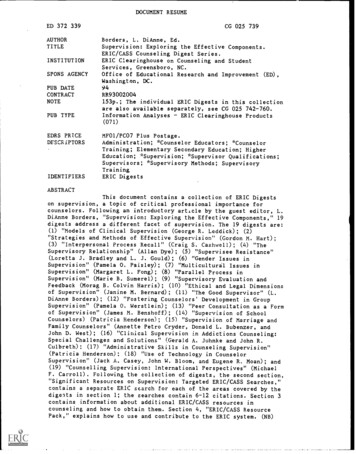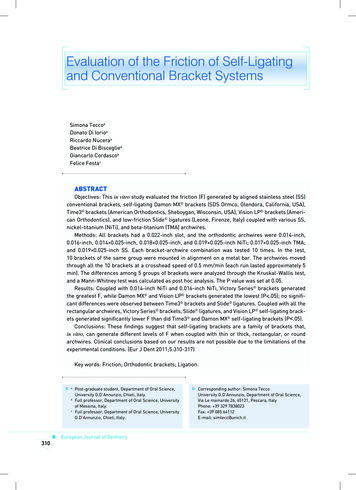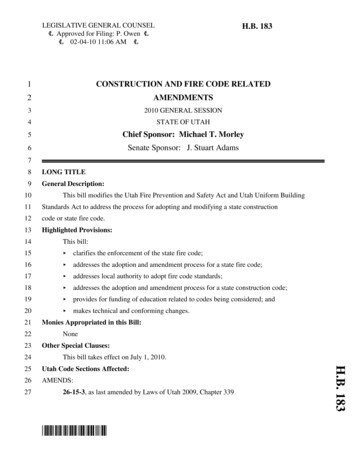
Transcription
DOCUMENT RESUMEED 372 339AUTHORTITLEINSTITUTIONSPONS AGENCYPUB DATECONTRACTNOTEPUB TYPECG 025 739Borders, L. DiAnne, Ed.Supervision: Exploring the Effective Components.ERIC/CASS Counseling Digest Series.ERIC Clearinghouse on Counseling and StudentServices, Greensboro, NC.Office of Educational Research and Improvement (ED),Washington, DC.94RR93002004153p.; The individual ERIC Digests in this collectionare also available separately, see CG 025 742-760.Information AnalysesERIC Clearinghouse Products(071)EDRS PRICEDESCRIPTORSIDENTIFIERSMF01/PC07 Plus Postage.Administration; *Counselor Educators; *CounselorTraining; Elementary Secondary Education; HigherEducation; *Supervision; *Supervisor Qualifications;Supervisors; *Supervisory Methods; SupervisoryTrainingERIC DigestsABSTRACTThis document contains a collection of ERIC Digestson supervision, a topic of critical professional importance forcounselors. Following an introductory article by the guest editor, L.DiAnne Borders, "Supervision: Exploring the Effective Components," 19digests address a different facet of supervision. The 19 digests are:(1) "Models of Clinical Supervision (George R. Leddick); (2)"Strategies and Methods of Effective Supervision" (Gordon M. Hart);(3) "Interpersonal Process Recall" (Craig S. Cashwell); (4) "TheSupervisory Relationship" (Allan Dye); (5) "Supervisee Resistance"(Loretta J. Bradley and L. J. Gould); (6) "Gender Issues inSupervision" (Pamela O. Paisley); (7) "Multicultural Issues inSupervision" (Margaret L. Fong); (8) "Parallel Process inSupervision" (Marie B. Sumerel); (9) "Supervisory Evaluation andFeedback (Morag B. Colvin Harris); (10) "Ethical and Legal Dimensionsof Supervision" (Janine M. Bernard); (11) "The Good Supervisor" (L.DiAnne Borders); (12) "Fostering Counselors' Development in GroupSupervision" (Pamela O. Werstlein); (13) "Peer Consultation as a Formof Supervision" (James M. Benshoff); (14) "Supervision of SchoolCounselors) (Patricia Henderson); (15) "Supervision of Marriage andFamily Counselors" (Annette Petro Cryder, Donald L. Bubenzer, andJohn D. West); (16) "Clinical Supervision in Addictions Counseling:Special Challenges and Solutions" (Gerald A. Juhnke and John R.Culbreth): (17) "Administrative Skills in Counseling Supervision"(Patricia Henderson): (18) "Use of Technology in CounselorSupervision" (Jack A. Casey, John W. Bloom, and Eugene R. Moan); and(19) "Counselling Supervision: International Perspectives" (MichaelF. Carroll). Following the collection of digests, the second section,"Significant Resources on Supervision: Targeted ERIC/CASS Searches,"contains a separate ERIC scerch for each of the areas covered by thedige3ts in section 1; the searches contain 6-12 citations. Section 3contains information about additional ERIC/CASS resources incounseling and how to obtain them. Section 4, "ERIC/CASS ResourcePack," explains how to use and contribute to the ERIC system. (NB)
ERIC/CASSCOUNSELING DIGEST SERIESSUPERVISIONEXPLORING THE EFFECTIVE COMPONENTSL. DIANNE BORDERS, PH.D.U.S. DEPARTMENT OF EDUCATIONOftce of Educational Research and ImprovementGUEST EDITOREDUCATIONAL RESOURCES INFORMATIONCENTER (ERIC)C This document has been reproduced asreceived from the Person or organizationoriginating it.Minor changes have been made to improvereproduction outlayPomts of view or opinions slated in this docu .ment do not necessarily represent officialOERI position or pohcyERIC/1111111MMINM72BEST COPY AVAILABLE
ER1C/CASSCOUNSELING DIGEST SERIESSUPERVISIONEXPLORING THE EFFECTIVE COMPONENTSCONTRIBUTORSL. DIANNE BORDERS, PH.D.GUEST EDITORJames M. BenshoffJanine M. BernardJohn W. BloomMargaret L. FongL. J. GouldMorag B. HarrisGrodon M. HartPatricia HendersonGerald A. JuhnkeGethge R. LeddickEugene R. MoanPamela 0. PaisleyMarie B. SumerelPamela 0. WerstleinJohn D. WestL. Di Anne BordersLorena J. BradleyDonald L. BubenzerMichael F. CarrollJack A. CaseyCraig S. CashwellAnnette Petro CryderJohn R. CulbrethAllan DyeERIC/CASSERIC
SUPERVISION DIGEST SERIESExploring the Effective ComponentsEditor: L. Di Anne BordersPrefaceGarry R. WalzERIC/CASSIntroductionL. Di Anne BordersUniversity of North Carolina at Greensboro, Greensboro, NCModels of Clinical SupervisionGeorge R. LeddickIndiana University - Purdue Univeristy, Fort Wayne, INStrategies and Methods of Effective SupervisionGordon M. HartTemple University, Philadelphia, PAInterpersonal Process RecallCraig S. CashwellMississippi State University, Mississippi State, MSThe Supervisory RelationshipAllan DyeRollins College, Winter Park, FLSupervisee ResistanceLoretta J. Bradley and L. J. GouldTexas Tech University, Lubbock, TXGender Issues in SupervisionPamela 0. PaisleyAppalachian State University, Boone, NCMulticultural Issues in SupervisionMargaret L. FongMemphis State University, Memphis, TNParallel Process in SupervisionMarie B. SumerelRaleigh, NCSupervisory Evaluation and FeedbackMorag B. Colvin HarrisEast Texas State University, Commerce, TXEthical and Legal Dimensions of SupervisionJanine M. BernardFairfield University, Fairfield, CT
The Good SupervisorL. Di Anne BordersUniversity of North Carolina at Greensboro, Greensboro, NCFostering Counselor's Development in Group SupervisionPamela 0. WerstleinUniversity of North Carolina at Greensboro, Greensboro, NCPeer Consultation as a Form of SupervisionJames M. BenshoffUniversity of North Carolina at Greensboro, Greensboro, NCSupervision of School CounselorsPatricia HendersonNorthside Independent School District, San Antonio, TXSupervision of Marriage and Family CounselorsAnnette Petro Cryder, Donald L. Bubenzer, and John D. WestKent State University, Kent, OHClinical Supervision in Addictions Counseling: Special Challenges and SolutionsGerald A. Juhnke and John R. CulbrethUniversity of North Carolina at Greensboro, Greensboro, NCAdministrative Skills in Counseling SupervisionPatricia HendersonNorthside Independent School District, San Antonio, TXUse of Technology in Counselor SupervisionJack A. CaseySonoma State University, Rohnert Park, CAJohn W. Bloom and Eugene It MoanNorthern Arizona University, Flagstaff, AZCounselling Supervision: International PerspectivesMichael F. CarrollRoehampton Institute, London, England5iv
TABLE OF CONTENTSList of ContributorsList of Digests and AuthorsTable of ContentsPrefaceviiIntroduction1Supervision DigestsModels of Clinical Supervision3Strategies and Methods of Effective Supervision5Interpersonal Process Recall7The Supervisory Relationship9Supervisee Resistance11Gender Issues in Supervision13Multicultural Issues in Supervision15Parallel Process in Supervision17Supervisory Evaluation and Feedback19Ethical and Legal Dimensions of Subervision21The Good Supervisor23Fostering Counselors' Development in Group Supervision25Peer Consultation as a Form of Supervision27Supervision of School Counselors29Supervision of Marriage and Family Counselors31Clinical Supervision in Addictions Counseling:Special Challenges and Solutions33Administrative Skills in Counseling Supervision35Use of Technology in Counselor Supervision37Counselling Supervision: International Perspectives39ERIC
Significant Resources on Supervision:Targeted ERIC/CASS Searches41Models of Clinical Supervision43Strategies and Methods of Effective Supervision47Interpersonal Process Recall51The Supervisory Relationship55Supervisee Resistance59Gender Issues in Supervision65Multicultural Issues in Supervision67Parallel Process in Supervision71Supervisory Evaluation and Feedback75Ethical and Legal Dimensions of Supervision79The Good Supervisor83Fostering Counselors' Development in Group Supervision87Peer Consultation as a Form of Supervision91Supervision of School Counselors93Supervision of Marriage and Family Counselors97Clinical Supervision in Addictions Counseling:Special Challenges ana Solutions101Administrative Skills in Counseling Supervision103Use of Technology in Counselor Supervision107Counselling Supervision: International Perspectives111Additional ERIC/CASS Resources on Counseling115ERIC/CASS Resource Pack133ERIC/CASS Digest Series Under Development161This publication was partially funded by the U.S. Department of Education, Office of Educational Researchand Improvement, Contract No. RR93002004. Opinions expressed in this report do not necessarily reflectthe positions of the U.S. Department of Education, OERI, or ERIC/CASS.7vi
PREFACEBetween these covers is a part of history. This is the first time in ERIC that there hasbeen a planned effort to produce a series of Digests on a topic of critical professionalimportance where each Digest explores a different facet of the topic. Our goal wasto produce a resource of multiple uses - professional self-renewal, classroom instruction, or in-service training programs.Digests have become the Educational Resources Information Center ERIC's mostfrequently used resource. Unlike ERIC documents, they are available in full text online (EDO) on CD-ROM, e.g., Silver Ratter, or via Internet. What is said in a Digest isliterally heard (or read) around the world.To introduce this new concept in Digest development, we made two importantdecisions. First, we needed a topic of compelling interest in counseling that lent itselfto dissection into highly targeted separate Digests. We chose supervision because ofthe interest being shown in it in all aspects of counselor development, pre- and inservice, and as a topic of personal professional renewal. Also, we adjudged thatthere were persons writing on supervision who were knowledgeable and capablewriters. Secondly, perhaps most importantly, we needed to identify a guest editorwho could conceptually develop the topic and recruit persons who could write ondifferent aspects of supervision with substance and flair. Additionally, the guest editorhad to be a kind of literary sergeant who would see that everyone followed the planand was on time. We chose wisely. Dr. Borders was an outstanding guest editor. Herchoice of topics and writers was first-rate as was her editing. We are indebted to herfor a superb job.This volume consists of four major sections. The first section contains 19 differentDigests. The second section provides a separate ERIC search for each of the areascovered by the Digests. The third section contains information about additional ERIC/CASS resources on counseling and how to obtain them. The fourth section offers theERIC/CASS Resource Pack which explains how to use and contribute to the ERIC system. This will provide the user with invaluable backup resources for pursuing a topic ingreater depth.The first of the ERIC/CASS Digest Series was a team effort. In addition to the superior work of the writers and the editor was the invaluable help provided by SandyRitter and Chester Robinson in editorial assistance, by Linda Favreau in typing andmanuscript preparation (all graduate students at UNCG) and Davida Sharpe for com-pleting the seraches - an intern with us from North Carolina A&T State University Graduate Program. New Digest Series are in preparation as we write. Please call or write forup-to-date information.We earnestly hope you find this to be a useful resource. We welcomeyour comments.Garry R. Walz, Ph.D., NCCDirector, ERIC/CASSSenior Research Scientist, University of North Carolina at GreensboroProfessor Emeritus, University of Michiganvii8
AlbMSSApril 1994Introduction toSupervision: Exploring the Effective ComponentsL. DiAnne BordersWhen I completed my dissertation study ir. 1984, athorough review of the literature was a fairly e asy task,CaveatsA few caveats are necessary. First, despite the number of digests included, the series could not cover everyrelevant topic. For example, several representative digestsaddress supervision issues specific to a particular worksetting or counseling issue (i.e., schools, substance abuse,marriage and family). Counselors, however, work in amyriad of other work settings, with clients who presentconcerns on a wide continuum from normal developmental issues to pathology. Thus, the digest series cannot beconsidered inclusive of all the supervision being provided(or needed) by counselors. Second, not every critical po:ntcould be included within a digest. Editing and deletingoften were painful; readers are urged to consult referenceslisted in each digest for further information about eachas the conceptual and empirical writings on cc unselingsupervision were limited. My review, however, includedtwo ardcles proposing innovative models that describeda developmental sequence of supervision experiencesneeded across the counselor's professional lifespan. Thesetwo developmental models of supervision (i.e., Loganbill,Hardy, & Delworth, 1982; Stoltenberg, 1981) subsequentlyspurred a rebirth of interest in the field and led to anexplosion of research and writings about supervision inthe United States and abroad. Today, even though a number of important questions remain unanswered, we nowhave a wealth of information about the conduct of effective supervision.The timing of this supervision digest series seemsmost appropriate, as there is much to be learned from thepast twelve or so years of supervision writings. Summarizing such a voluminous body of literature is a difficulttask, particularly in a digest format. I believe the readerwill find, however, that the digest authors have successfully described the state of the art in each supervision area.In addition, each has pointed the way for the next twelveyears, identifying emerging trends and key issues needing to be addressed. Collectively, the supervision digeststopic.Definition of Counseling SupervisionPerhaps surprisingly, I believe it is important - if notnecesary - to provide a definition of the focus of the digest series. Supervision is often equated with casestaffings or, as a doctoral student recently noted, "a seriesof case conferences." And, as Bernard and Goodyearmay provide an impetus for the next advancements in(1992) indicated, supervision is often confused with training, counseling, and consultation. Supervision, however,is all of these things integrated into a unique professionalrole in whichthe field.In terms of the specific content of the supervisiondigests, an overview of basic components of the supervision enterprise axe first. Components discussed by theauthors include models of supervision, supervision strategies (including an expanded focus on IPR), a variety ofrelationship dynamics (i.e., supervisee resistance, genderand multi-cultural issues, parallel process), feedback andevaluation, ethical and legal issues, and the supervisor.Two authors then describe particular formats of supervision, group supervision and peer consultation. Severalwriters next address unique supervision issues in a specific work setting (i.e., schools) and counseling specialtyAn intervention is provided by a senior member of aprofession to a junior member or members of that sameprofession. This relationship is evaluative, extends overtime, and has the simultaneous purposes of enhancingthe professional functioning of the junior member(s),monitoring the quality of professional services offered tothe clients she, he, or they see(s), and serving as agatekeeper for those who are to enter the particular profession. (Bernard & Goodyear, 1992, p. 4)areas (i.e., marriage and family counseling, substanceSupervision, then, is focused on educating the counselor rather than treating the client. It may be focused ondeveloping a counselor 's therapeutic skills, ability toconceptualize a client, professional behaviors and attitudes, or self-awareness about how one's personal traitsabuse counseling). Finally, three authors address the specialized topics of administrative aspects of a supervisor'srole, innovative uses of technology in supervision, andthe status of supervision outside the US.19
and issues may affect counseling performance. It mayinvolve a role play, videotape review, skill practice, or modeling. It may be structured or open-ended, directive or collaborative, confrontive or supportive, depending on the learn-then adding the final product to the fine collection of ERIC/CASS counseling materials.ing needs, learning style, and personality of the counselor.Whatever the particular format or focus of a session, it is intentional, purposeful, crafted, and hard work for the supervisor and supervisee. It also may be the lifeblood for acounselor's growth and job satisfaction.Association for Counselor Education and Supervision. (1993,The importance of supervision in the counseling fieldcannot be overstated. Perhaps of most relevance to thisBernard, J. M., & Goodyear, R. K. (1992). Fundamentals ofclinical supervision. Boston: Allyn & Bacon.digest series, it is clear that supervision is a pivotal learningexperience for counselors, for both student:- in training programs and practitioners in the field. In fact, 12 iere is someevidence that only supervised counseling experience (vs.unsupervised experience) contributes to counselor growthReferencesSummer). Ethical guidelines for counseling supervisors.ACES Spectrum, 53(4), pp 5-8.Borders, L. D., Bernard, J. M., Dye, H. A., Fong, M. L.,Henderson, P., & Nance, D. W. (1991). Curriculum guide fortraining counseling supervisors: Rationale, development, andandEducationCounselorimplementation.(e.g., Wiley & Ray, 1986). It also is clear that the role of supervision in our profession is becoming even more critical, givenSupervision, 31, 58-80.the increasing numbers of licensure bills that require postdegree supervision. Moreover, state licensure boards (alongwith members of our profession) increasingly are recognizing the importance of supervision by qualified supervisorswith specialized training and supervised experience in coun-and Supervision, 31, 208-218.seling supervision (e.g., Borders & Cashwell, 1992).Borders, L. D., & Cashwell, C. S. (1992). Supervision regulations in counselor licensure legislation. Counselor EducationBorders, L. D., & Leddick, G. R. (1987). Handbook of counsel-ing supervision. Alexandria, VA: Association for CounselorEducation and Supervision.Falvey, J. E. (1987). Handbook of administrative supervision.Supervision Interest Network ProjectsThis digest series should be considered in the context ofprojects of the Supervision Interest Network of the Association for Counselor Education and Supervision (ACES). Overthe last ten years, the Network (with ACES support) has sponsored a number of products designed to enhance the field ofcounseling supervision, including handbooks of counseling(Borders & Leddick, 1987) and administrative supervision(Falvey, 1987), standards of practice (Dye & Borders, 1990;Alexandria, VA: Association for Counselor Education andSupervision.Dye, H. A., & Borders, L. D. (1990). Counseling supervisors:Standards for preparation and practice. Journal of Counselingand Development, 69, 27-32.Loganbill, C., Hardy, E., & Delworth, U. (1982). Supervision: A conceptual model. The Counseling Psychologist,10(1), 3-42.ACES Supervision Interest Network, 1993), and trainingC. (1981). Approaching supervison from aguidelines (Borders, Bernard, Dye, Fong, Henderson, & Stoltenberg,developmental perspective: The counselor complexity model.Nance, 1991). The digest series builds on these projects in animportant way, both updating and expanding previous work.It is hoped that this supervision series will be used as a basisfor supervisor training programs in academic and work settings.AcknowledgementsEvery author should receive a standing ovation for producing their digests within a very limited timeframe. Eachenthusiastically accepted the invitation to write on a particular topic and then delivered on their promises. I am mostgrateful for their interest, support, and expertise, and ampleased to have worked with such an esteemed group ofwriters.Journal of Counseling Psychology, 28, 59-65.Wiley, M. L., & Ray, P. B. (1986). Counseling supervision bydevelopmental level. Journal of Counseling Pyschology, 33, 439445.L. DiAnne Borders, Ph.D., is an associate professor of counseloreducation at the University of North Carolina at Greensboro.Finally, Dr. Garry Walz deserves particular appreciationfor proposing this series, helping develop the digests, andERIC Digests are in the public domain and may be freely reproduced and disseminated. This publication was funded by the U.S. Department of Education, Office of Educational Research and Improvement, Contract No. RR93002004. Opinions expressed in this report do notnecessarily reflect the positions of the U.S. Department of Education, OEM or ERIC/CASS.For information on other ERIC/CASS products and services, please call toll-free (800) 414-9769 or (910) 334-4114 or fax (919)334-4116 or write ERIC/CASS, School of Education, University of North Carolina at Greensboro, Greensboro, NC 27412.10
MI11/MKsusANILApril 1994EDO-CG-94-08Models of Clinical SupervisionGeorge R. LeddickOverviewClinical supervision is the construction of individualized learning plans for supervisees working with cli-ents. The systematic manner in which supervision isapplied is called a "model." Both the Standards for Supervision (1990) and the Curriculum Guide for Counsel-because supervisee self-concept is easily threatened.Advanced supervisees function independently, seek consultation when appropriate, and feel responsible for theircorrect and incorrect decisions.Once you understand that these levels each includethree 'processes (awareness, motivation, autonomy),ing Supervision (Borders et al., 1991) identify knowledgeof models as fundamental to ethical practice.Stoltenberg and Delworth (1987) then highlight contentSupervision routines, beliefs, and 'practices beganemergmg as soon as therapists wished to train otherstechniques, interpersonal assessment, client conceptuali-(Leddick & Bernard, 1980). The focus of early training,however, was on the efficacy of the particular theory (e.g.behavioral, psychodynamic, or client-centered therapy).Supervision norms were typically conveyed indirectlyduring the rituals of an apprenticeship. As supervisionbecame more purposeful, three types of models emerged.These were: (1) developmental models, (2) integratedmodels, and (3) orientation-specific models.Developmental ModelsUnderlying developmental models of supervision isthe notion that we each are continuously growing, in fitsand starts, in growth spurts and patterns. In combiningour experience and hereditary predispositions we developstrengths and growth areas. The object is to maximizeand identify growth needed for the future. Thus, it istypical to be continuously identifying new areas of g-rowthin a life-long learning process. Worthington (1987)reviewed developmental supervision models and notedpatterns. Studies revealed the behavior of supervisorschanged as supervisees gained experience, and thesupervisory relationship also changed. There appearedto loe a scientific basis for developmental trends and patterns in supervision.Stoltenberg and Delworth (1987) described a developmental model with three levels of supervisees: beginning, intermediate, and advanced. Within each level theauthors noted a trend to begin in a rigid, shallow, imitative way and move toward more competence, self-assurance, and self-reliance for each level. Particular attentionis paid to (1) self-and-other awareness, (2) motivation, and(3) autonomy. For example, typical development inbeginning supervisees would find them relatively dependent on the supervisor to diagnose clients and establishplans for therapy. Intermediate supervisees woulddepend on supervisors for an understanding of difficultclients, but would chafe at suggestions about others. Resistance, avoidance, or conflict is typical of this stage,of eight growth areas for each supervisee. The eightareas are: intervention, skills competence, assessmentzation, individual differences, theoretical orientation,treatment goals and plans, and professional ethics. Helping supervisees identify their own strengths and .arowthareas enables them to be responsible for their life-longdevelopment as both therapists and supervisors.Integrated ModelsBecause many therapists view themselves as "eclectic," integrating several theories into a consistent practice, some models of supervision were designed to beemployed with multiple therapeutic orientations.Bernard's (Bernard & Goodyear, 1992) DiscriminationModel purports to be "a-theoretical." It combines anattention to three supervisory roles with three areas offocus. Supervisors might take on a role of "teacher" whenthey directly lecture, instruct, and inform the supervisee.Supervisors may act as counselors when they assistsupervisees in noticing their own "blind spots" or themanner in which they are unconsciously "hooked" by aclient's issue. When supervisors relate as colleagues during co-therapy they might act in a "consultant" role. Eachof the three roles is task-specific for the purpose of identifying issues in supervision. Supervisors must be sensitive toward an unethical reliance on dual relationships.For example, the purpose of adopting a "counselor" rolein supervision is the identification of unresolved issuesclouding a therapeutic relationship. If these issuesrequire ongoing counseling, supervisees should pursuethat work with their own therapists.The Discrimination Model also highlights threeareas of focus for skill building: process, conceptualization, and personalization. "Process" issues examine howcommunication 's conveyed. For example, is the supervisee reflecting the client's emotion, did the superviseeref rame the situation, could the use of paradox help theclient be less resistant? Conceptualization issues includehow well supervisees can explain their application of aspecific theory to a particular case how well they seethe big pictureas well as what reasons supervisees
may have for what to do next. Personalization issues pertainto counselors' use of their persons in therapy, in order thatall involved are nondefensively present in the relationship.For example, my usual body language might be intimidatingto some clients, or you might not notice your client is physically attracted to you.The Discrimination Model is 'Primarily a training model.It assumes each of us now have habits of attending to someroles and issues mentioned above. When you identify yourcustomary practice, you can then remind yourself of the othertwo categories. In this way, you choose interventions gearedto the needs of the supervisee instead of your own preferences and learning style.Orientation-Specific ModelsCounselors who adopt a particular brand of therapyBernard and Goodyear (1992) summarized advantagesand disadvantages of psychotherapy-based supervision models. When the supervisee and supervisor share the same orientation, modeling is maximized as the supervisor teachesand theory is more integrated into training. When orientations clash, conflict or parallel process issues may predominate.SummaryAre the major models of supervision mutually exclusive,or do they share common ground? Models attend systematically to: a safe supervisory relationship, task-directed structure, methods addressing a variety of learning styles, multiple supervisory roles, and communication skills eithancinglistening, analyzing, and elaboration. As with any model,your own personal model of supervision will continue togrow, change, and transform as you gain experience and in-(e.g. Adlerian, solution-focused, behavioral, etc.) oftentimesbelieve that the best "supervision" is analysis of practice for sight.true adherence to the therapy. The situation is analogous tothe sports enthusiast who believes the best future coach wouldReferencesbe a person who excelled in the same sport at the high school,college, and professional levels. Ekstein and Wallerstein (cited Association for Counselor Education and Supervision (1990).Standards for counseling supervisors. Journal of Counselin Leddick & Bernard, 1980) described psychoanalytic supering and Development, 69, 30-32.vision as occurring in stages. During the opening stages thesupervisee and supervisor eye each other for signs of exper- Bernard, J. M., Goodyear, R. K. (1992). Fundamentals of clinitise and weakness. This leads to each person attributing acal supervision. Boston, MA: Allyn & Bacon.degree of influence or authority to the other. The mid-stageis characterized by conflict, defensiveness, avoiding, or Borders, L. D., Bernard, J. M., Dye, H. A., Fong, M. L.,attacking. Resolution leads to a "working" stage for supervision. The last stage is characterized by a more silent super-Henderson, P., & Nance, D. W. (1991). Curriculum guidevisor encouraging supervisees in their tendency towardfor training counselor supervisors: Rationale, development, and implementation. Counselor Education and Su-participate as co-therapists to maximize modeling andvision: A critical review. Counselor Education and Super-pervision, 31, 58-80.independence.Behavioral supervision views client problems as learn- Goodyear, R. K . (1982). Psychotherapy supervision by major theorists [videotape series]. Manhattan, KS: Instructionaling problems; therefore it requires two skills: 1) identificaMedia Centertion of the problem, and (2) selection of the appropriate learning technique (Leddick & Bernard, 1980). Supervisees can Leddick, G. R. & Bernard, J. M. (1980). The history of super-increase the proximity of reinforcement. Supervisees also canengage in behavioral rehearsal prior to working with clients.Carl Rogers (cited in Leddick & Bernard, 1980) outlinedvision, 27, 186-196.McDaniel, S., Weber, T. , & McKeever, J. (1983). Multiple theo-retical approaches to supervision: Choices in familya program of graduated experiences for supervision in clitherapy training. Family Process, 22, 491-500.ent-centered therapy. Group therapy and a practicum werethe core of these experiences. The most important aspect of Stoltenberg, C. D., & Delworth, U. (1987) Supervising counselors and thera
and was on time. We chose wisely. Dr. Borders was an outstanding guest editor. Her. choice of topics and writers was first-rate as was her editing. We are indebted to. her. for a superb job. This volume consists of four major sections. The first section contains 19 different Digests. The second section provides a separate ERIC search for each .









